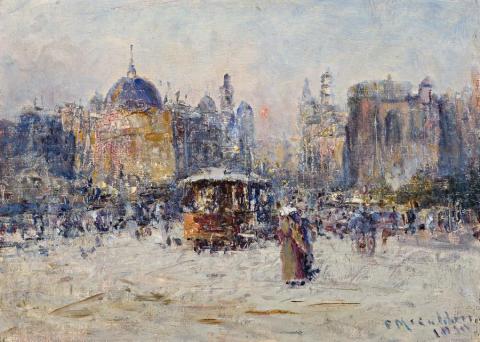PRINCES BRIDGE, 1910
FREDERICK McCUBBIN
oil on canvas-board
25.0 x 35.0 cm
signed and dated lower right: F McCubbin / 1910
W. R. Sedon, Melbourne (label attached verso, as 'Swanston St from Princes Bridge', 1910)
Private collection, Melbourne
Deutscher Fine Art, Melbourne
Trevor Bussell, Sydney (label attached verso)
Sotheby's, Melbourne, 19 August 1996, lot 140
Private collection, Melbourne
Frederick McCubbin exhibition to mark the centenary of the artist's birth in 1855, National Gallery of Victoria, Melbourne, 4 November – 31 December 1955, cat. 34 (label attached verso, lent by W.R. Sedon Esq.)
Australian Colonial and Impressionist Paintings, Deutscher Fine Art, Melbourne, 22 March – 9 April 1982, cat. 31 (illus. in exhibition catalogue)
McCubbin: Last Impressions 1907–1917, National Gallery of Australia, Canberra, 14 August – 1 November 2009;
Art Gallery of Western Australia, Perth, 12 December 2009 – 28 March 2010;
Bendigo Art Gallery, Victoria, 24 April – 25 July 2010 (label attached verso)
Gray, A., McCubbin: Last Impressions 1907–1917, National Gallery of Australia, Canberra, 2009, cat. 30 (illus. p. 99 and frontispiece)
Frederick McCubbin sketchbooks, National Gallery of Victoria, Melbourne
Of all the Australian Impressionist artists, Frederick McCubbin is one of those most admired. The freedom and spontaneity of his technique in latter years is the closest to French Impressionism of any of his contemporaries; and his subjects have long had an appeal that distinguishes him as a master of Australian art. The early years were devoted to the toils and tribulations of the pioneers, as in Down on His Luck, 1889 (Art Gallery of Western Australia, Perth), and The Pioneer, 1904 (Felton Bequest, National Gallery of Victoria, Melbourne) enshrined in the format of a triptych reserved for pictures of a religious nature. It is well known that his trip to England and the Continent in 1907 transformed his art through the creative influence of the British artist he long admired, J.M.W. Turner. His technique became freer, adopting a sparkling rainbow palette to capture the atmosphere of the shaded bush he so loved and the many moments of his home city of Melbourne. Princes Bridge, 1910 is a superb example of the latter.
McCubbin was born within the city where he grew up and later worked as Drawing Master at the National Gallery School. Throughout his life his approach to its streets and buildings was one of familiarity, as seen in such works as Falls Bridge, Melbourne, 1882, and Melbourne in 1888, 1888, (both in the collection of the National Gallery of Victoria). In 1901 he sketched in oil Triumphal Arch at Princes Bridge, Melbourne (National Gallery of Australia, Canberra), the bridge resplendent to celebrate the opening of Australia's first Federal Parliament by the Duke of York. Following McCubbin's return from England, he translated his plein air sketch into a painting of Turnerian magnificence, Arrival of the Duke and Duchess of York, Melbourne, 1901, 1908 (National Gallery of Victoria), a precursor to our own painting. McCubbin began painting his later city views in about 1906, Swanston Street, 1906 being similar in view to our painting, seen from the left side of the bridge. Another, Princes Bridge, 1906, shows bridge and buildings from the south side of the Yarra River.1 In Princes Bridge, 1910, McCubbin returned to his 1906 view, now showing the newly completed dome of Flinders Street Station, the nearby St Paul's Cathedral yet to have its Gothic spires. Bravura and freedom of the palette knife combine in the dance of light and colour across the picture surface expressing the bustle of late afternoon city life. The atmosphere appealed so much that he painted other similar sized and styled works - Flinders Street, Early Morning and Flinders Street Railway Station, c1910-12, and two version of Collins Street, c1915 in which colour and light again are paramount.2
1. For Swanston Street, 1906, see MacDonald, J., The Art of Frederick McCubbin, Lothian Book Publishing, Melbourne, 1916, pl., xxviii. Princess Bridge, 1906 was originally purchased by The Melbourne Herald from Sedon Galleries
2. Private collections, Geelong Art Gallery and National Gallery of Victoria respectively
DAVID THOMAS
